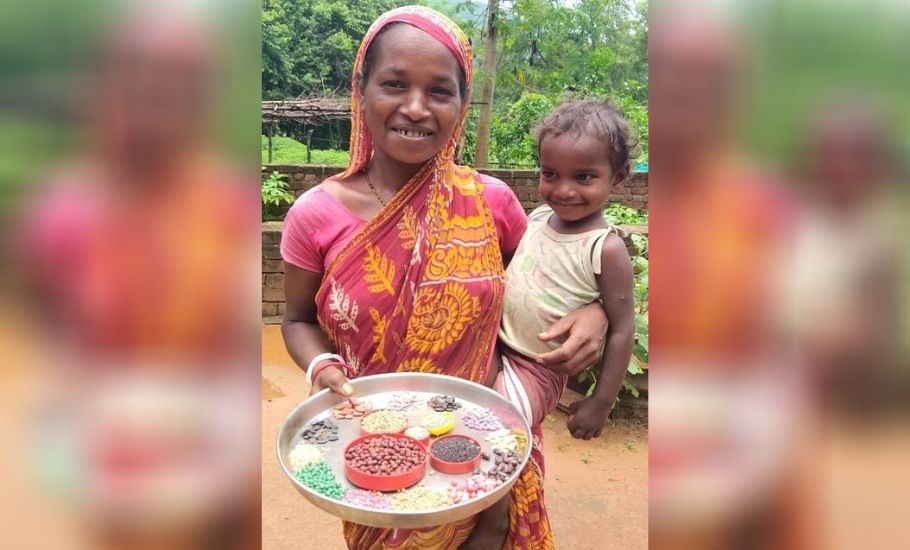
'Tiranga' meals helping Jharkhand villagers fight malnutrition
‘Tiranga bhojan’ means the inclusion of food items of the three different colours in the daily diet to boost the health of their children—saffron represents proteins from pulses, lentils, and meat; white represents carbohydrate from boiled rice, and green represents vitamins and minerals from leafy vegetables.

Manko Mardi always remained worried about the health of her four-year-old child Som. The malnourished boy would often fall sick, prompting a visit to the local doctors.
So was the condition of the other residents of Sundar-Kanali village, which falls under the Ghatsila block of Jharkhand’s East Singhbhum district. Here, with the poor villagers always busy fighting the hunger of their families, nutrition remained their last priority.
But, then came ‘Tiranga bhojan‘, meaning tricolour diet.
For the villagers, ‘Tiranga’ does not only mean the three different colours of the country’s national flag — saffron, white, and green. It also signifies the foundation of nutrition and good health.
‘Tiranga bhojan’ means the inclusion of food items of the three different colours in the daily diet to boost the health of their children—saffron represents proteins from pulses, lentils, and meat; white represents carbohydrate from boiled rice, and green represents vitamins and minerals from leafy vegetables.

Now, the villagers have made it their habit to include these food items in their diet after being advised by the Centre for World Solidarity (CWS), a non-governmental organisation (NGO) involved in activities for combating undernutrition in the area.
The development followed shocking stories from the region.
In 2013, Jharkhand’s Deoghar district had reported a large number of infant deaths, drawing the attention of this NGO which later conducted a hunger-mapping exercise in 50 villages. Findings that emerged after extensive details were collected from the villagers alarmed the CWS authorities.
Related news: To tackle malnutrition, govt to identify locally available nutritious food
Of the total population surveyed, 14.6 per cent were found chronically ill, 20.5 per cent malnourished, while the remaining 64.9 per cent had some kind of disease. Further analysis of their dietary intake found the majority of the villagers ate starchy foods—boiled rice with potato—abundantly available in the region. Even though some villagers grew pulses and vegetables in the fields, they mainly sold them in the local market to earn money to run their family.
It was here that the CWS counselling worked wonders.
“We identified the factors behind the poor child mortality rate in the area but the main issue was how to convey this message to the poor, uneducated villagers. So, we took help from the colours of our national flag to make people understand how different colours of foods determine our health and keep us secure from diseases,” state CWS director Rajesh Jha told The Federal over the phone.
Related news: India 102 in world hunger index, below Pakistan, Nepal, Bangladesh
He said the people of Jharkhand are very laborious, but the poor villagers were ignorant about nutrient foods and didn’t know its importance even if they grew such food items in their own kitchen gardens.
“So, we launched extensive campaigns about how to include various coloured foods in the regular diet. We encouraged them to grow a variety of vegetables in the kitchen gardens and also provided seeds to them free of cost. Besides, we organised nutrition camps at regular intervals where we informed them about the importance of various coloured foods and how to make one’s diet nutritious,” he said.
“The move has brought tremendous change in the region,” Jha added. Such has been its impact that the campaign, which began from Deoghar, has now spread to seven other districts of Jharkhand and also in Bihar now.
Related news: Poor nutrition pushes Jharkhand, MP at bottom of child well-being index
Locals said they have noticed pleasant changes in their lives since they focussed on nutrition and were provided basic information about the factors impacting a child’s health. “Previously, the villagers would reach the Anganwadi centres only to collect foods, but now you can see them going there with their children to know about their growth reports,” exclaimed Shefali Mahato, a local woman from Ghatshila.
Growth monitoring and promotion of children from birth to five years is one of the important components of the Integrated Child Development Services programme. Weight-for-age is used as an indicator for detecting early growth faltering, assessing nutritional status and taking appropriate measures on the first signs showing inadequate growth or no weight gain or loss of weight for preventing and reducing undernutrition.
Such has been the impact of the continuous campaigns that a mother is not only cooking good food for her children but also for the entire family. “A pregnant woman is now aware of the fact that lack of good nutrient food means the birth of a malnourished baby, which again means shuttling between home and doctors’ clinics,” said another villager, Salma Murmu.


